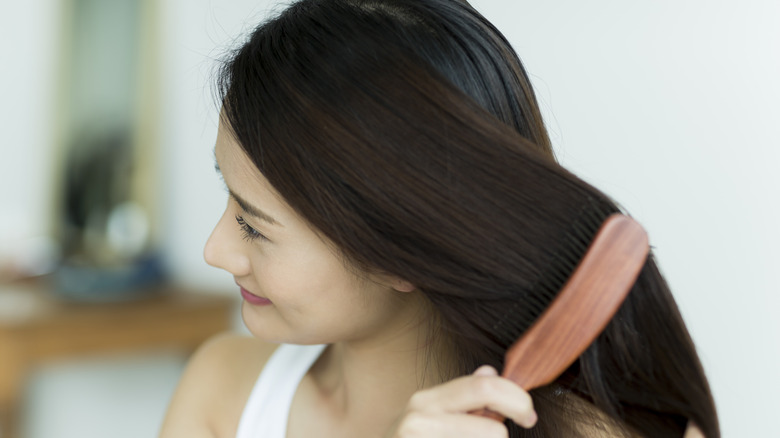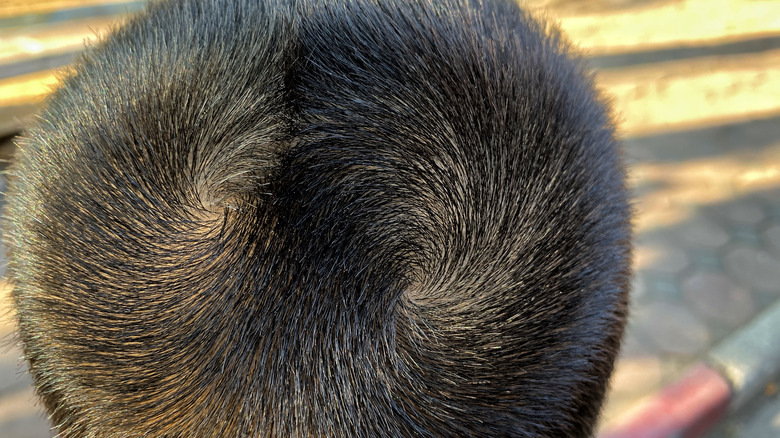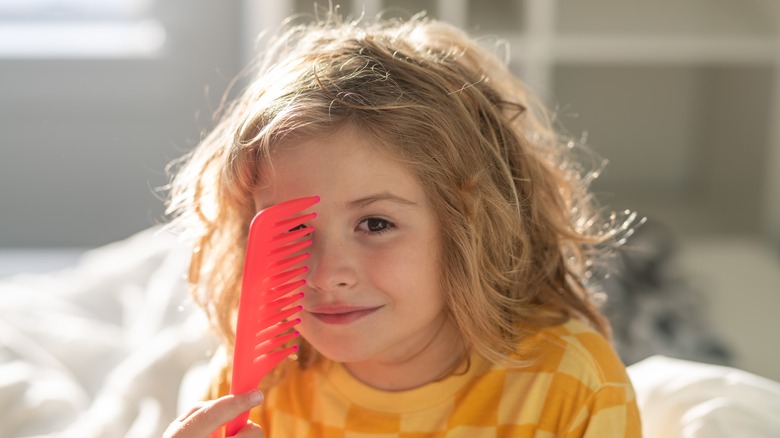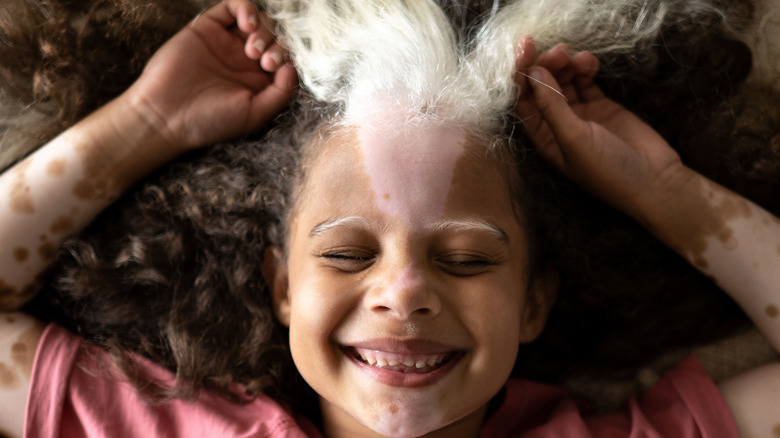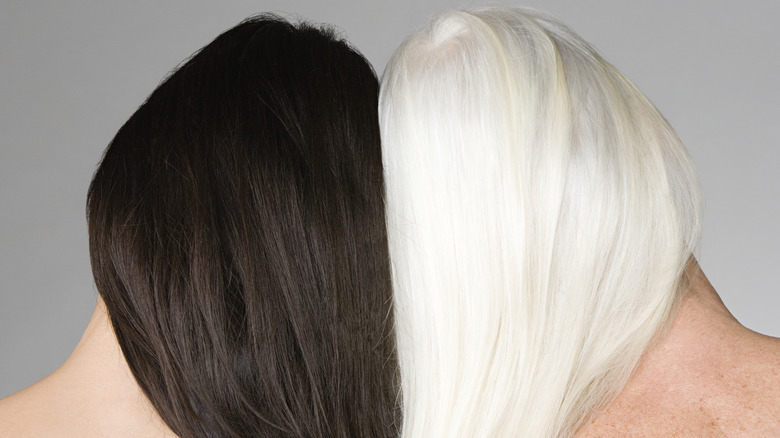The Rarest Hair Features A Person Can Have
Hair characteristics extend well beyond basic terms like dry, straight, bouncy, thin, curly, etc. In fact, many people find that these characteristics continuously change throughout childhood and into late adulthood due to various lifestyle factors, medications, shedding, aging-related hair loss, and more, per a review in the International Journal of Cosmetic Science. Our hair is unique to each of us in many ways. The contributing factors that influence hair's growth patterns, shape, and color have not always been entirely clear. Yet research shows that our genes play a significant role in the biology and diversity of our locks.
When we think of genetics in connection with our hair, your mind probably first goes to hair color. While 85% of people in the U.S. are reported to have black hair, red hair can only be found among a rare 1% of the population, according to World Population Review. Some people, however, are born with hair features that are even more rare. This includes individuals with Type 1A hair, double hair whorls, uncombable hair syndrome, piebaldism, and heterochromia of the scalp hair. Let's take a look at each of these features and get a better idea of what makes them so uncommon.
What is Type 1A hair?
Hair type is split into four groups as genetically determined by its curl pattern, explains Healthline. These categories are Type 1, Type 2, Type 3, and Type 4 and stand for straight, wavy, curly, and coily, respectively. Within each category are subtypes. For example, within the category of Type 2 hair (wavy), you'll find Type 2A, Type 2B, and Type 2C, with each subtype becoming progressively more wavy. The entirety of the head isn't limited to one hair type, though. Rather, different sections of our hair may fall into different categories.
The rarest of the rare is Type 1A hair, which is characterized by straight hair that is completely devoid of any curl. While Type 1A hair can be either fine or thick in texture, it generally has less body and gives off a more sleek and shiny appearance, according to experts at Danish Body Care. This fast-growing hair type can also be prone to breakage and may or may not hold a curl when attempting to style it. It's estimated that Type 1A hair is so rare that you'll find it in only 2% of the population.
Hair whorls
The presence of a whorl, or spiral pattern, in one's hair is not uncommon. Researchers from a 2005 study published in the scientific journal Genetics note that you can find a hair whorl on the tops of the heads of more than 95% of the population. What is rare, however, is the presence of two hair whorls, sometimes referred to as a double whorl or a double crown (via Healthline). Any more than two of these patterns would be considered exceedingly rare. Direction also matters when it comes to hair whorls. Most often, a person will have one spiral growing in a clockwise direction on their scalp, although a small number of people have been found to have counterclockwise hair whorls on their head.
When it comes down to the numbers, a rare double whorl can be found in only about 5% of the population, explains the National Human Genome Research Institute. Additionally, only 10% of humans have a counterclockwise hair whorl. Although most people do have one clockwise hair whorl around the vertex of the skull, the pattern is sometimes tricky to spot, especially in people whose hair may be longer or curlier. Some research has also found that a number of people may alternatively have a diffuse hair whorl pattern on the scalp (via the Journal of Investigative Dermatology).
Uncombable hair syndrome
Generally isolated to childhood, uncombable hair syndrome is another rare hair feature a person can have that is unique to kids, explains the Cleveland Clinic. Children with this genetic condition have hair on their head growing in various different directions rather than all strands growing down towards the floor. With signs usually emerging around the age of three, the child's hair may appear coarse, frizzy, dry, shiny, or hypopigmented. These factors pose challenges when attempting to flatten, style, or brush the child's hair. Although there is no cure for the condition, uncombable hair syndrome will eventually take care of itself as children transition into their teen years. While there are more than 100 documented medical cases of the condition, prevalence rates are likely higher.
To avoid exacerbating symptoms, refrain from excess brushing and minimize the use of blow dryers, hair straighteners, and curling wands on the child's hair. Getting their hair cut on a routine basis can also be helpful, but steer clear of any harsh chemical treatments. Alternatively, results of a 2023 study published in the Journal of the European Academy of Dermatology and Venereology showed that low-dose biotin supplementation when taken three years apart helped improve a case of uncombable hair syndrome in a 3-year-old girl. It's important to note, however, that children should not be given any medication, including supplements, without doctor approval.
Piebaldism
It is also a rare trait for a person to have a white tuft of hair situated towards the front of their head, referred to as a white forelock (via Medical News Today). This can be a sign of a genetic condition known as piebaldism, which occurs due to an absence of melanin-containing cells in certain areas of the body. It's melanin that is responsible for the pigmentation of our skin, eyes, and hair. Therefore, those with the condition may also have patches of white skin, often seen on areas of the arms, legs, chest, or forehead.
Piebaldism is thought to be the product of a gene mutation. Approximately half of all individuals with the condition will have kids with the condition, too. According to 2023 research published in StatPearls, both men and women are susceptible to piebaldism, and the condition is estimated to affect less than 1 in every 20,000 people. A white forelock is the primary symptom of the condition and often resembles a triangle or diamond in shape.
Heterochromia of the scalp hair
As it turns out, dyeing your hair isn't the only way in which a person can end up with two different hair colors. While only a very small number of cases have been reported, research shows that some people, primarily children, can develop what's known as heterochromia of the scalp hair. Heterochromia is a condition in which a person possesses two different eye colors, such as one eye that is blue and another that is a shade of brown (via Cleveland Clinic). The same is true for cases of heterochromia of the scalp, with the difference being that an individual's hair is two distinct colors rather than the eyes.
In a 2019 case report published in the International Journal of Trichology, a 2-year-old boy with black hair was found to have patches of blonde hair on both sides of the head. Similarly, an alternate 2010 scientific report published in the Canadian Medical Association Journal outlined the case of an 11-year-old boy with black hair who presented with a large patch of bright, light brown hair at the vertex of the skull surrounding a singular hair whorl. The researchers noted that while some cases of heterochromia of the scalp may be associated with iron deficiency anemia, pigmentary disorders, metabolic dysfunction, the use of certain medications, and more, there are cases that have been documented unrelated to a health condition. In these instances, experts theorize that there may be a pigmentation-related genetic component involved.


